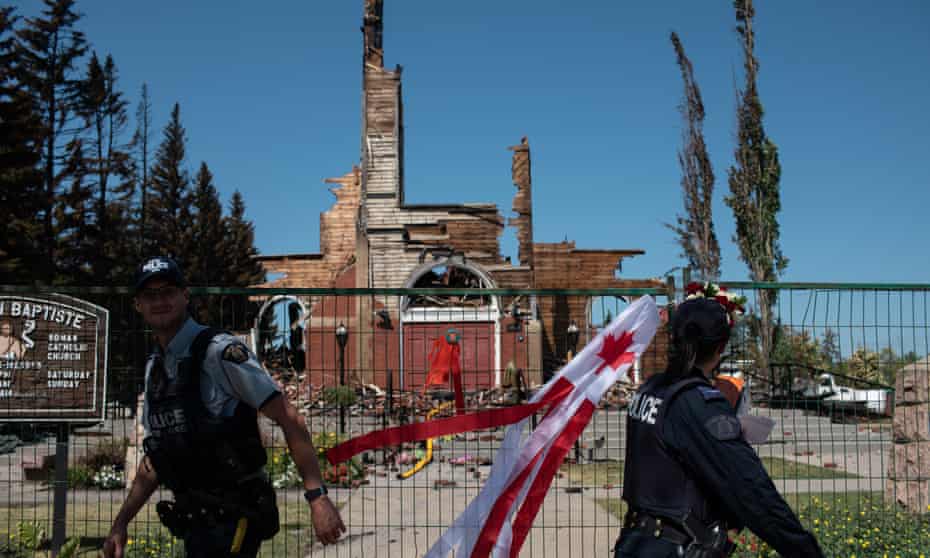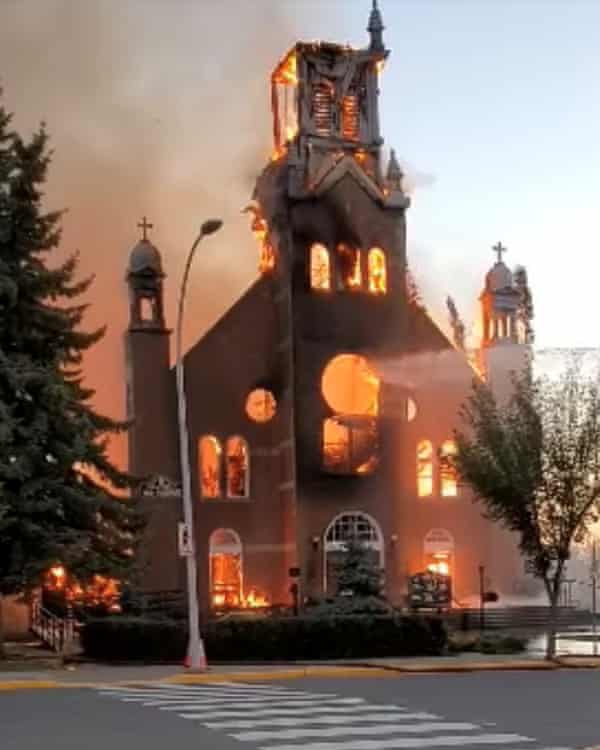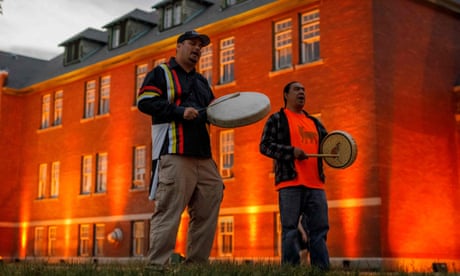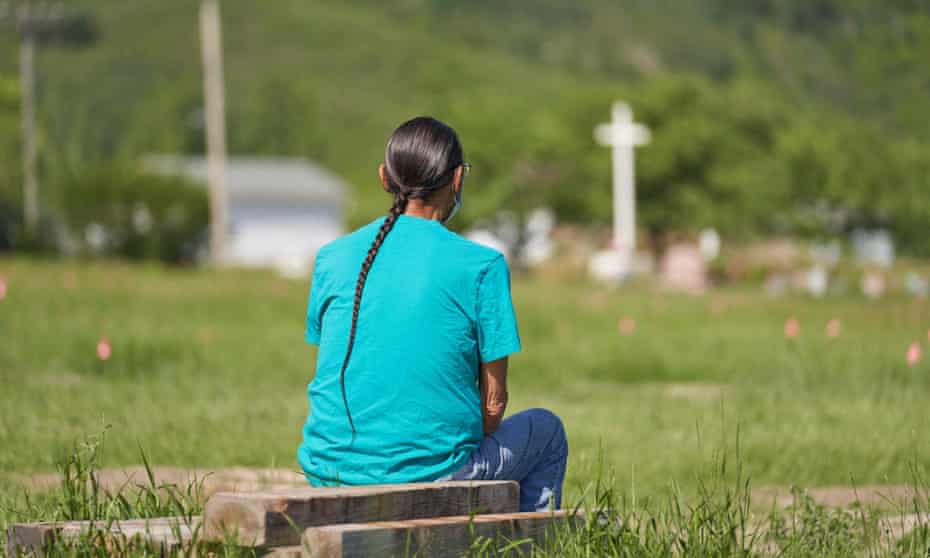Lytton, BC Fire
- Thread starter B00Mer
- Start date
You are using an out of date browser. It may not display this or other websites correctly.
You should upgrade or use an alternative browser.
You should upgrade or use an alternative browser.
One slight problem! While you can cut loose from the religion, it's much harder to cut loose from the God. who doesn't have a hand in this sh*t!Well written Guardian article about church burnings
Burned churches stir deep Indigenous ambivalence over faith of forefathers

Firefighters inspect the damage at the burned-out Roman Catholic St Jean Baptiste church in Morinville, Alberta, Canada.
After hundreds of unmarked graves were found at Canada’s former Catholic-run residential schools, churches in First Nations territories have been destroyed by suspected arson
For more than a century, the clapboard church set amid rolling hills in western Canada has been a spiritual home to the Upper Similkameen Indian Band.
To build St Anne’s, residents of Chuchuwayha Indian Reserve #2 travelled 40 miles to the closest town, hauling lumber back to their community by horse and wagon.
To reach its pews, generations of congregants would travel miles by foot, past ponderosa pine and sagebrush.
But early last Saturday, thick smoke filled the air and flames ripped through the ageing wooden structure near Hedley in British Columbia. By the time local fire crews arrived, the church had been reduced to a pile of ash.

Fire destroys a Catholic church in Morinville, Alberta, this week.
The community’s fire chief said nothing could be done to save the wooden building. Police say the fire that destroyed the church was suspicious and probably deliberately set. It was the fourth Catholic church on First Nations territory destroyed by fire in less than a month.
“The church meant so much to all of us, especially our ancestors,” Carrie Allison, an elder who helped maintain the church, said in a statement. “When your hurt turns to rage it is not healthy for you or your community.”
As Canada grapples with the discovery of more than 1,000 unmarked graves of Indigenous children at the sites of former residential schools, many have directed their grief and anger at the Catholic church, which ran more than half of the schools across the country.
Disease and hunger were rife at the schools, and survivors have described physical and sexual abuse, often at the hands of priests and Catholic laypeople.
In recent weeks, nearly two dozen churches have been burned or vandalized across the country – eight of which occurred in First Nations territories.
Justin Trudeau joined Indigenous leaders and provincial officials in condemning what are widely suspected to be acts of arson.
“I can’t help but think that burning down churches is actually depriving people who are in need of grieving and healing and mourning from places where they can grieve and reflect and look for support,” the prime minister said on Friday.

But for many Indigenous people, churches summon contradictory and conflicting emotions: they are the spaces built by their ancestors where generations were baptised and buried, but they also represent the destruction of Indigenous culture and more than a century of fear and physical abuse.
From the 19th century until the 1990s, more than 150,000 Indigenous children were obliged to attend state-funded schools in a campaign to forcibly assimilate them into Canadian society. More than half were run by the Catholic church; thousands of children died of disease, neglect and other causes.
“Those innocent souls were scarified for colonialism,” said Amelia McComber, an Indigenous practitioner and theologian. “And that sacrifice has become the focal point of the hurt and the trauma that has gone on for generations in our communities.”
Entering the schools, children were forbidden to speak their mother tongue, and forced to convert to Christianity. Generations later, many of Indigenous people in Canada still identify as Christian.
“We are a spiritual people and that spirituality was transferred to Christ, because that was the only way our people could pray [in the residential schools]. That was the only way that they could worship,” said McComber.

A man sits and prays at the field where the remains of over 750 children were buried on the site of the former Marieval Indian residential school in Cowessess First Nation, Saskatchewan, last month.
Some have suggested that First Nations communities should consider cutting all ties with a religion they say was imposed on them.
“It is a legitimate debate for First Nations to talk about removing Catholic churches from our territories, and establishing our own faith as the official religion,” tweeted the writer Robert Jago. “Canada and [First Nations] – these aren’t 100% separate societies – but religion is one of the places they are, or should be.”
But as more churches are burned or vandalized, Indigenous leaders have pleaded for the buildings – many more than a century old – to be spared, despite the anger.
“I can understand it. I don’t like the church. I don’t believe in the church,” chief Clarence Louie of the Osoyoos Indian Band told the National Post, after the church in his community was destroyed. “Many residential school survivors hate the church with a passion – but I have never heard any of them ever suggest people turn to this … I talk to a lot of residential school survivors and, sure, there is a lot of hatred and bitterness and anger – but that still doesn’t mean you go and do arson.”
For Allison, a survivor of the Kamloops Indian residential school, the fire has only worsened the pain.
“I think of all our ancestors that helped to build St Anne’s, looking over us and watching all their hard work and the place they cherished burn to the ground,” she wrote. “A lot of us suffered, but this is not how we do things, and this is not our way. It makes me so sick, sad, and I can only hope I do not know you. I feel sorry for you, and I hope you’re satisfied.”
God can't help them, he is in quarantine. He's not vaccinated.
Hot boxes are a common occurrence.A video of a hot wheel or "the video of the hot wheel"?
C.N. probably has a better lawyer than the guy accused of setting it! Did the guy who reported the train fire not snap a picture?Human caused is now the going theory not a train.
I've often seen prescribed burns besides the tracks around here to prevent fires.....a dry wheel bearing is often the cause of a fire
Yep, but hopefully not at 48C.I've often seen prescribed burns besides the tracks around here to prevent fires.....a dry wheel bearing is often the cause of a fire
A welfare night grease fire is the most probable. 3 days post child tax and post welfare, sirens are nonstop.I've often seen prescribed burns besides the tracks around here to prevent fires.....a dry wheel bearing is often the cause of a fire
If you know it's coming...... Lytton is a microclimate. Its always really freaking hot.Yep, but hopefully not at 48C.
It gets 48C along the side of my garage too, does that mean it's a record?
There's a few criteria, like it can't be reflected heat and it has to be exactly 5' off the ground and there's a bunch of other shit that has to be complied with!If you know it's coming...... Lytton is a microclimate. Its always really freaking hot.
It gets 48C along the side of my garage too, does that mean it's a record?
This one didn’t. Whoopsies….Is started with a church and spread.
Sparks from RCMP trailer ignited wildfire near Lytton, B.C., say police — CBC News
Police say a wildfire north of Lytton began on Tuesday when the right side wheel of an RCMP trailer flew off, causing sparks to ignite the dry grass ditch. It came one day after the fourth anniversary of a blaze that destroyed most of the B.C. village.
I've often seen prescribed burns besides the tracks around here to prevent fires.....a dry wheel bearing is often the cause of a fire
Yes it is incredible watching a hot box shooting sparks into the arid grassland .